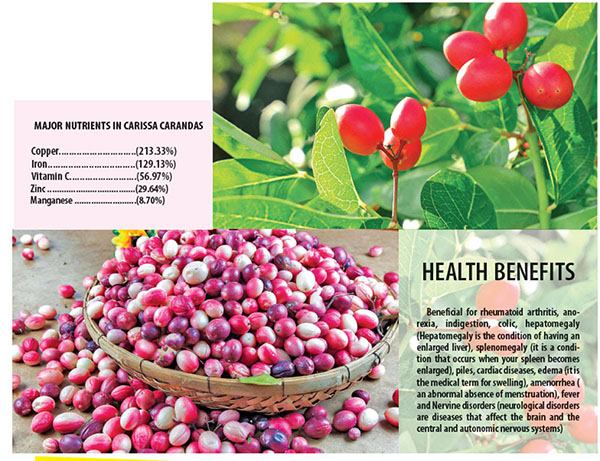Jamson fruit – Tasty and healthy – by Ishara Jayawardane

Dr. Swarna Hapuarachchi
Source:Daily News
The history of plants certainly leads us in mysterious directions. The Carissa Carandas is one such plant which is locally known as Jamson. It shares a certain English name with two other plants. Green Thumbs speaks to Institute of Indigenous Medicine, Department of Dravyaguna Vignana, Senior Lecturer, Dr. S.D. Hapuarachchi, on this plant that belongs to the Apocynaceae family. Common names in English include Bengal Currant, Christ’s Thorn, Carandas Plum and Karanda.
Fascinatingly the Paliurus Spina Christi plant is also known as Christ’s Thorn!. It is a shrub forever immortalized due to the fact that according to oral tradition its spiny branches were supposedly used to make the crown of thorns placed on Christ’s head before his crucifixion. The fruit is a dry woody nutlet. It is native to the Mediterranean region.
Interestingly there is another thorny plant that is a native of Madagascar called Crown of thorns, (Euphorbia milii), which is also called Christ thorn!. It too refers to the thorny crown Jesus was forced to wear during his crucifixion. It is popular as a houseplant and is grown in warm climates as a garden shrub and it’s known for its brilliant red flowers.
“In Ayurveda, it is named as Karamarda. Properties of this plant is described in ancient Ayurveda text as a medicine native to India, Nepal, Sri Lanka, Malaysia, Thailand, Myanmar and China. It is a pinkish red fruit with a white hue. Its fruit is used in the ancient Indian herbal system of medicine, Ayurvedic, to treat acidity, indigestion, fresh and infected wounds, skin diseases, urinary disorders and diabetic ulcer, as well as biliousness, stomach pain, constipation, anemia, skin conditions, anorexia and insanity. The Leaf decoction is used to treat fever, diarrhea, and earache. The roots serve as a stomachic, an anthelmintic medicine for itches and also as insect repellents,” said Dr. Hapuarachchi.
Jamson is a climbing shrub or small tree usually growing 3 – 5 meters tall. It is very attractive when in fruit, and the plant is often grown in the garden both as an ornamental and for its fruit in tropical and subtropical areas. It is not usually grown commercially. When unripe it has a sour taste, and when ripe, the fruits have a sweet and sour taste.
“The fruit is rich in iron, vitamin C, vitamins A, calcium and phosphorus. In India, the mature fruit is harvested for Indian pickles. It contains pectin and accordingly is a useful ingredient in chutney. Ripe fruits exude a white latex when severed from the branch. The Colonial British in India also made jelly, jams and syrups from it. The fact that it is rich in iron makes it extremely beneficial for anemic patients. Since it is rich in Vitamin C it is excellent for growth and repair of tissues in the body. The fruit is also used to cure the effect of scurvy,” explained Dr. Hapuarachchi.
Carissa Carandas can reduce the blood sugar levels and aids in managing diabetes. It has a Thermogenic attribute which aids in reducing weight, making it an effective medication for obesity. In a world that is extremely stressful, Carissa Carandas can help manage or even cure anxiety. It has an anthelmintic impact on the body which expels the parasitic worms. It removes impurities from the blood. It regulates and optimizes the heart functions to avoid heart diseases. It has an analgesic attribute that is essential in providing relief from pain.
Carissa carandas has a high nutraceutical (another term for functional food) value. The study has revealed that the fruits can be used as dietary supplement as well as therapeutic agent as they would exert several beneficial effects by virtue of their antioxidant activity.
Hapuarachchi explains that the plant normally flourishes well in regions with high temperatures. Thus, it is found in abundance in Western Ghats of Konkan region in the western coastal states of Maharashtra and Goa. Nevertheless, it grows naturally even in the temperate conditions of Siwalik Hills of Himalayas in India and Nepal at elevations of 30 to 1,800 meters (98 to 5,906 ft). In the rest of India, it is grown on a limited scale in Rajasthan, Gujarat, Bihar, West Bengal and Uttar Pradesh. It grows naturally in most South Asian countries like in the lowland rain forests of Sri Lanka and in other countries like Nepal, Afghanistan, and Bangladesh.
Historical sources tell us that back in the 19th century, eastern India was separated from the west by an impenetrable belt of trees made up of mostly thorny plants. They formed a man-made barrier, more than a thousand kilometers long, that snaked all the way from Layyah in Punjab (now in Pakistan) to Burhanpur, on the banks of Narmada. The hedge was composed mainly of Indian plum, babool, karonda (Carissa Carandas) and Euphorbia.
The Great Hedge of India was planted by the British in the 1840s to strengthen the Inland Customs Line that the colonial rulers set up to exploit one of the most basic ingredients of every Indian food—salt.









No Comments